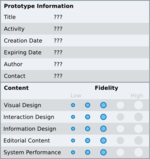User Experience/Tools
|
|
|---|
|
Quick Navigation Team Communication Activities |
This page describes tools, e.g. application software, that are useful for User Experience related work. It complements the already existing page Resources. Please note that software tools are not meant to replace either in-depth analysis or intensive thinking ;-)
For each entry there will be information on recommended use, advantages, disadvantages or further readings. In general, it isn't possible to say that a certain tool is far superior than another one - sometimes it is just a matter of personal preference. However, if you use any kind of software, please make sure that created documents can be shared among the community. That is the only way to let others benefit from your work.
Feel free to add entries or own experiences and please don't forget to explain them so that the information helps others estimate the tools' usefulness. Thanks!
Research
 Know and understand OpenOffice.org users to better meet their needs.
Know and understand OpenOffice.org users to better meet their needs.
| Name | Description | Used | Examples |
|---|---|---|---|
| OpenOffice.org User Feedback Program |
The OpenOffice.org User Feedback Program is a collection of tools to gather, transfer and analyse usage statistics by real users of OpenOffice.org. The use of dialogs, menus, toolbars and shortcut keys is counted and transferred to a central server if the user accepts an agreement. The collected data exported to simple spreadsheets or analysed in various ways. The User Feedback Program provides insight into the real use of functionality available in the office suite. It is shipped with OpenOffice.org since version 3.1. Please note that only usage data is collected; nor document content nor personal information are part of the gathered data. According to the intended audience - and sometimes due to inconsistent naming - the User Feedback Program is also called "Usage Tracking" or "OpenOffice.org Improvement Program". References:
OpenOffice.org contact person: Frank Loehmann (FL) |
yes |
Impress Click Map |
| LimeSurvey.org |
LimeSurvey is an open-source survey application to provide online surveys which are hosted on an usual webserver. The surveys can be provided in different languages and with a customized design, e.g. for OpenOffice.org. The survey design and some analysis is available within the administration pages of the software. Website: www.limesurvey.org/en/ OpenOffice.org contact person: Frank Loehmann (FL) |
yes | OpenOffice.org User Survey |
Design
 Generate and accumulate ideas to create innovative design proposals.
Generate and accumulate ideas to create innovative design proposals.
| Name | Description | Used | Examples |
|---|---|---|---|
| Inkscape |
Inkscape is a very powerful open-source vector graphics editor which uses the W3C standard Scalable Vector Graphics (SVG) file format. The created graphics can be exported to the PNG format so that they can be used in both the Wiki or OpenOffice.org. Recommended use: diagrams, GUI mockups, icons Advantages:
Disadvantage: OpenOffice.org is not able to handle SVG files Website: www.inkscape.org Useful stuff:
|
yes |
Mockups for the print dialog |
| The Gimp |
The Gimp is a very powerful open-source bitmap graphics editor. The created graphics can be exported in various formats so that they can be used in both the Wiki or OpenOffice.org. Recommended use: GUI mockups (especially modifying existing screenshots), simulation of color vision deficiency, image composition, very simple animations Advantages:
Disadvantages:
Useful stuff:
Website: www.gimp.org |
yes |
|
| OpenOffice.org Draw / Impress |
Draw is the drawing application and Impress is the presentation application of the OpenOffice.org office suite. So why not use OpenOffice.org to design OpenOffice.org? Recommended use: GUI mockups, diagrams, clickable prototypes and animations (Impress) Advantages:
Disadvantages:
Website: www.openoffice.org Useful stuff: OpenOffice.org Galaxy Color Palette (Galaxy Icon Style, Colors in Draw Document) |
yes |
|
| Paper and Pencil |
The "Paper and Pencil" approach is simply the use of a sheet of paper and a pencil to draw early sketches. It is named here, since its usefulness is often underestimated. Drawing is the most natural approach, since you don't need to consider the requirements of a certain software tool. Simply start drawing and don't think about about artistic skills - you only need boxes and some text. The "Paper and Pencil" approach is directly related to the well known method "Paper Prototyping". Recommended use: very early GUI mockups, diagrams Advantage: Fast and flexible design Disadvantages:
|
yes |
|
| Pencil Project |
The Pencil Project is an open-source add-on for the Mozilla Firefox which uses the drawing engine of the browser. Recommended use: GUI mockups, diagrams Advantage:
Website: www.evolus.vn/Pencil/Home.html |
short test only |
none |
Evaluation
 Evaluate promising solutions and analyze the current design.
Evaluate promising solutions and analyze the current design.
| Name | Description | Used | Examples |
|---|---|---|---|
| Colorblind Web Page Filter |
The Colorblind Web Page Filter simulates color vision deficiency on already existing websites. There are several sets of color blindness filters which can be applied to a user-defined URL. That makes it possible to simulate vision deficiencies with nearly any website. But, please keep in mind that there are some elements on the websites which cannot be re-calculated. You will find further information on the website. Recommended use: simulation of color vision deficiency Advantages: Fast and easy simulation Disadvantages:
Website: colorfilter.wickline.org |
yes | OpenOffice.org Website and "red/green blindness" (Protan) |
| Portable Usability Lab |
A usability lab is used to check products with real end-customers. The Fedora Project currently develops a Portable Usability Lab which is rather cheap - compared to commercial solutions. Advantages: tbd Disadvantages: tbd Information: |
no | none |
Support and Documentation
| Name | Description | Link | Examples |
|---|---|---|---|
| OpenOffice.org Specification Project | Software specifications are an essential part of the OpenOffice.org development process. Changes to OpenOffice.org be it adding new feature or enhancing existing ones will be done based on written software specifications. This is absolutely necessary as there are always multiple persons or groups involved in a change to OpenOffice.org | Specification Project | Specifications which affect all OpenOffice.org modules |
| Fidelity Matrix |
Usually, it is really easy for viewers to mix up things like "visual design" and the "interaction design". In the literature, there has been a proposal to address such problems with an fidelity matrix which is supplied to each design artifact. Detailed information can be found in the blog entry "A Picture is Worth a Thousand Words!" by the UX Team. |
Personal Idea of a Welcome Center |
Further Topic Ideas
- OpenOffice.org Wiki
- OpenOffice.org Writer / Calc
- Issue Tracker
- Keyword: usability (Issues referring to usability and ease of learning should have this keyword.)
- Keyword: usagetracking (Usagetracking issues for Renaissance Project)
- Assigned to: ???
- Icon Test icon-test.com/en
- ASCII Art en.wikipedia.org/wiki/ASCII_art
- Enthnographic studies
- Focus groups
- Contextual inquiries (User interviews, User observations)
- Site visits
- OpenOffice.org Uninstallation Survey (will start with OOo 3.2)
- Text analysis:

